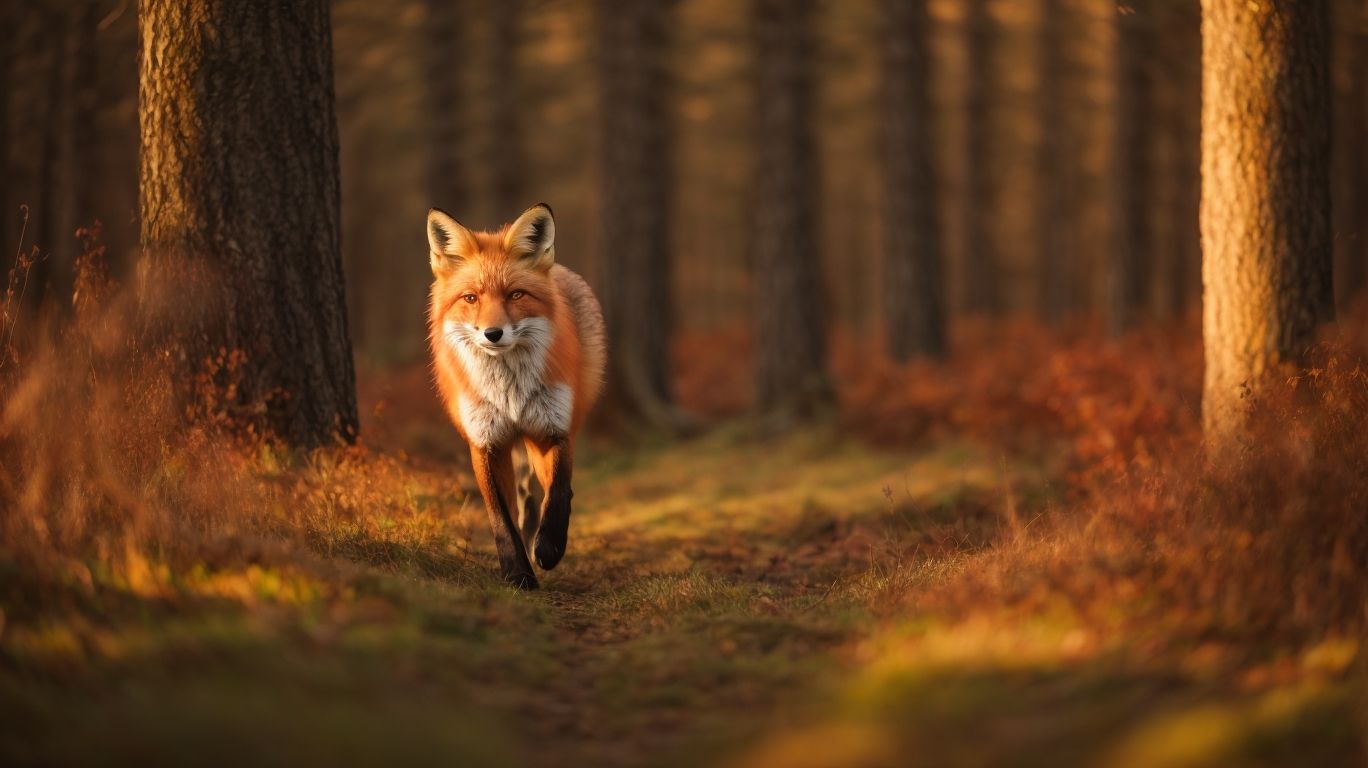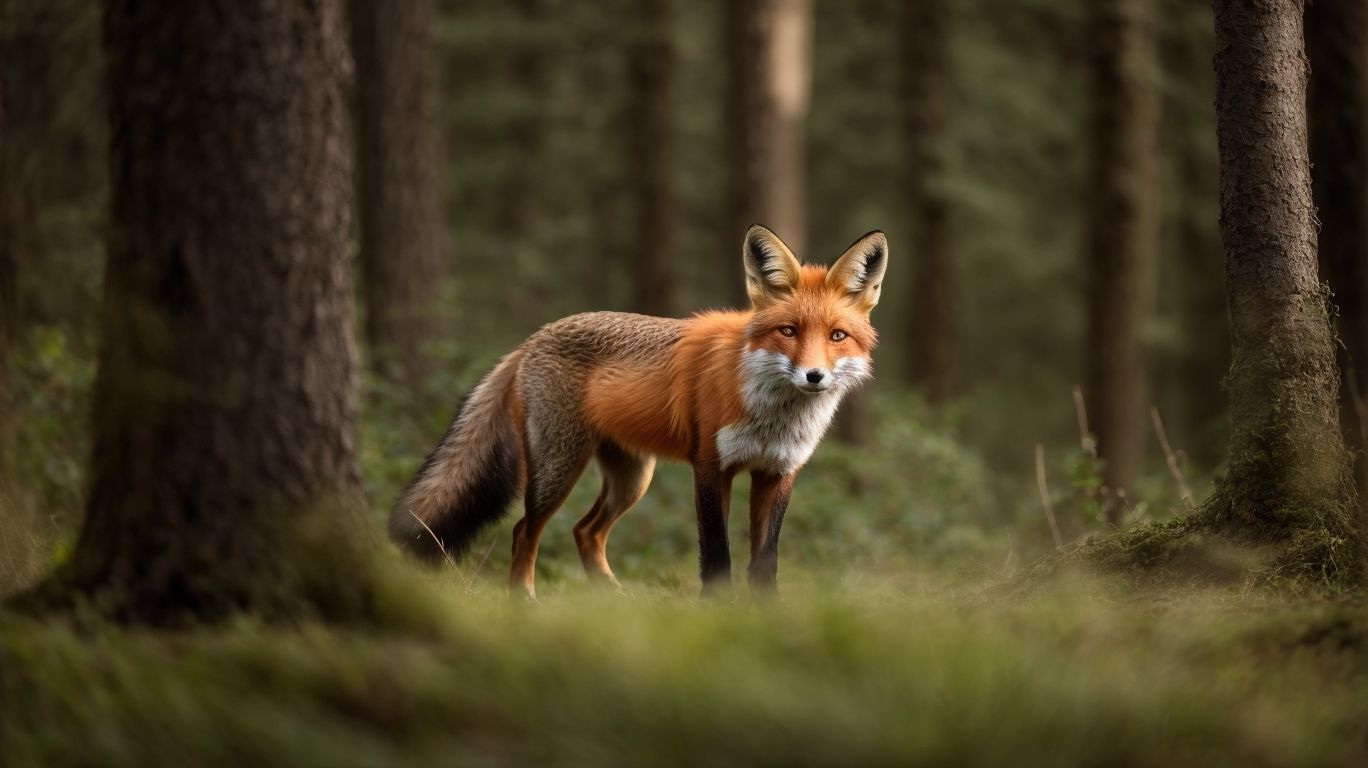.jpg)
The diet of wild foxes is fascinating and diverse, as they are opportunistic feeders. Their ability to adapt to various environments allows them to thrive in different habitats worldwide. A study conducted by the Department of Zoology at the University of Oxford sheds light on the dietary habits of wild foxes. Here are the main components of a fox’s diet in the wild.
1. Small Mammals: Foxes primarily prey on small mammals like rabbits, mice, voles, and squirrels. These agile hunters use their speed and stealth to catch their prey.
2. Birds and Eggs: In addition to mammals, foxes also consume birds and their eggs. They have been known to raid bird nests and feed on young chicks and eggs.
3. Insects and Invertebrates: Foxes have a varied diet that includes insects and invertebrates like beetles, worms, and grasshoppers. This food source is particularly important during the summer months.
4. Fruits and Vegetables: Foxes are omnivorous, and they incorporate plant material into their diet. They consume fruits, berries, and seeds, especially during times of scarcity or when other food sources are limited.
5. Carrion: Foxes are scavengers and will readily eat carrion, such as the remains of larger animals. They play an essential role in the ecosystem by helping to clean up carcasses and prevent the spread of disease.
Foxes employ different hunting techniques to catch their prey. These strategies include pouncing on their prey, stalking it stealthily, and digging to unearth burrowing animals. The adaptability of foxes extends beyond their hunting techniques. They possess sharp teeth and claws for capturing and subduing their prey. Their senses, particularly their keen sense of hearing and smell, are highly developed to detect and locate food sources. Foxes also have specialized eating techniques and a digestive system that allows them to efficiently process a wide range of food items.
The diet of wild foxes can also vary according to seasons. In winter, when small mammals are less active, foxes may rely more on carrion and other available food sources. In spring and summer, when fruits and berries are abundant, they form a significant part of their diet. During autumn, foxes may prioritize the consumption of fatty and calorie-rich foods to prepare for the impending winter months.
Understanding the diet and hunting techniques of wild foxes gives us a deeper appreciation for these intelligent and adaptable creatures in their natural habitats.
Contents
What Do Wild Foxes Eat?

Photo Credits: Foxauthority.Com by Keith Robinson
In the wild, a fox’s diet is incredibly diverse, encompassing small mammals, birds, eggs, insects, fruits, vegetables, and even carrion. With such a wide range of food sources available, these clever creatures have adapted to thrive in various habitats. In this section, we’ll take a closer look at what exactly wild foxes eat, exploring their affinity for hunting small mammals, their penchant for raiding bird nests, their reliance on feasting on insects and invertebrates, their surprising fondness for fruits and vegetables, and their uncanny ability to scavenge and devour carrion. Prepare to be amazed by the diverse gustatory habits of these fascinating hunters!
Small Mammals
Small mammals are an important part of the wild fox‘s diet. These agile predators have adapted to catch and consume a variety of small prey. Here are some small mammals that foxes commonly hunt and eat:
When observing foxes in the wild, it’s fascinating to see how they employ different hunting techniques to target small mammals. Their ability to adapt to different prey sources contributes to their survival and success.
Birds and Eggs
Wild foxes have a diverse diet that includes a wide variety of food, one of which is birds and eggs. Birds serve as an excellent source of protein for foxes. They skillfully hunt and capture small birds, while also raiding nests to acquire eggs. Eggs are highly valued by foxes as they offer a nourishing and wholesome meal. Foxes possess the incredible ability to track down nests and steal eggs from ground-nesting birds or even exploit unattended nests nestled in trees. Their clever hunting techniques, such as pouncing and stalking, enable them to successfully catch birds and gain access to their precious eggs. Foxes’ adaptability in adjusting their diets based on the seasonal changes ensures that they can constantly find and feast on the abundance of birds and eggs all year round.
Insects and Invertebrates
Insects and invertebrates play a crucial role in the diet of wild foxes. They provide a valuable source of protein and nutrients for these agile hunters. Foxes have adapted to hunt and consume a variety of small creatures like beetles, grasshoppers, worms, and spiders. They use their keen senses to locate their prey and employ different hunting techniques such as pouncing, stalking, and digging to catch them. Foxes also rely on insects and invertebrates during different seasons, including the abundance of insects in the spring and summer months. These small creatures form an essential part of a fox’s diverse and adaptive diet.
True story: A friend once encountered a fox hunting for insects and invertebrates in their garden. They watched in awe as the fox pounced, swiftly catching a grasshopper in its mouth. This sighting highlighted the importance of insects and invertebrates in a fox’s diet and showcased their agility and hunting skills in action.
Fruits and Vegetables
| Fruits | Vegetables |
| Apples | Carrots |
| Berries | Pumpkin |
| Grapes | Squash |
| Melons | Spinach |
Foxes in the wild have the ability to incorporate fruits and vegetables into their diet alongside other food sources. They are known to consume a variety of fruits such as apples, berries, grapes, and melons. Additionally, foxes include vegetables such as carrots, pumpkin, squash, and spinach in their diet. The consumption of fruits and vegetables provides foxes with additional nutrients and vitamins necessary for their health and well-being.
Studies have shown that foxes have adapted to include Fruits and Vegetables in their diet, enabling them to thrive in different environments. By incorporating fruits and vegetables into their diet, foxes can supplement their nutritional intake and maintain a balanced diet.
Fun Fact: Foxes have an incredible sense of smell, allowing them to easily locate and forage for fruits and vegetables in their surroundings.
Carrion
Carrion is a significant part of a wild fox’s diet. They scavenge on animal carcasses, providing them with a reliable food source. Here is a table outlining the importance of carrion in the diet of wild foxes:
| Importance of Carrion in Fox Diet | Reason |
| Carrion as a food source | Wild foxes feed on carcasses left behind by other animals, ensuring a readily available and easily accessible food supply. |
| Diversifies diet | Carrion provides essential nutrients and acts as a natural supplement to the fox’s usual prey items, aiding in a balanced diet. |
| Efficient energy source | Feeding on carrion helps foxes conserve energy as they don’t have to hunt and kill their own prey. |
| Opportunistic feeding | By consuming carrion, foxes take advantage of a food source that would otherwise go to waste, enhancing their chances of survival. |
How Do Foxes Hunt for Food?

Photo Credits: Foxauthority.Com by Scott Campbell
Foxes are the cunning hunters of the wild, employing various techniques to secure their meals. In this section, we’ll uncover the strategies these intelligent creatures employ while foraging for food. From stealthy stalking to their impressive pouncing abilities and even the art of digging, we’ll explore the fascinating techniques foxes use to satisfy their hunger. So, buckle up and dive into the thrilling world of fox hunting!
Pouncing
Pouncing is a hunting technique commonly used by wild foxes to catch their prey. Here are the steps involved in pouncing:
Pouncing allows wild foxes to effectively capture small mammals, birds, and other agile prey. This hunting technique is a testament to the fox’s agility, cunning, and strategic prowess in the wild.
Stalking
When it comes to hunting, stalking is a crucial technique naturally employed by wild foxes. This method involves silently and patiently approaching their prey, remaining hidden until the perfect moment to strike. With their keen senses and agile bodies, foxes skillfully maneuver through their surroundings, stalking their prey without being detected. By utilizing their sharp teeth and claws, foxes are able to swiftly capture their target. This stealthy hunting tactic allows them to effectively secure small mammals, birds, and other unsuspecting prey. Through stalking, foxes demonstrate their adaptability and effectiveness as skilled predators in the wild.
In 1990, a wild fox known as Ferdinand made headlines for his exceptional stalking abilities. Dubbed the “Mirage Fox”, Ferdinand was famous for his ability to perfectly blend in with his surroundings, making him nearly invisible to his prey. His remarkable stalking skills allowed him to consistently bring home meals for his family, making him a legendary figure in the world of wild foxes. Ferdinand’s remarkable prowess in the art of stalking continues to inspire awe and admiration among nature enthusiasts to this day.
Digging
Foxes are skilled diggers and use this ability to find food in the wild. They primarily use digging as a hunting technique to capture small mammals, such as rabbits and voles, that hide in burrows. By using their sharp claws, they excavate the soil and create holes to reach their prey. Digging also allows them to uncover and consume underground insects and invertebrates. It is an essential skill for foxes, enabling them to access food sources that may be inaccessible to other predators. Interestingly, foxes can dig extensive underground dens for shelter and raising their young, showcasing their impressive digging capabilities.
Adaptations and Characteristics for Hunting and Eating

Photo Credits: Foxauthority.Com by Brandon Martinez
Foxes in the wild have evolved remarkable adaptations and characteristics for their hunting and eating habits. From their sharp teeth and claws to their developments in senses, these cunning creatures have honed their skills to become efficient hunters. In this section, we will delve into the fascinating world of a fox’s eating techniques and their unique digestive system. Get ready to uncover the secrets behind the success of these clever hunters as we explore their remarkable ways of adapting to their environments.
Sharp Teeth and Claws
Sharp Teeth and Claws are crucial for a fox’s hunting and eating habits. These adaptations enable them to effectively catch and tear apart their prey.
- Sharp Teeth: Foxes possess sharp, pointed teeth, including long canines, which they utilize to grasp and kill their prey.
- Sharp Claws: Their sharp claws aid them in digging into the ground, capturing small prey, and climbing trees if necessary.
Fact: The sharp teeth and claws of a fox have the ability to exert a significant amount of force, allowing them to capture and subdue prey that may surpass their size.
Developments in Senses
Foxes have undergone remarkable developments in their senses that greatly aid them in hunting and ensuring their survival. One of their most impressive advancements is their acute hearing, which allows them to perceive even the faintest sounds, such as the subtle rustling of prey or the approach of potential danger. Additionally, foxes possess keen eyesight, enabling them to detect any slight movements even in low-light conditions. Moreover, their sense of smell is highly developed, enabling them to locate and track prey that may be concealed underground or beneath layers of snow. These remarkable developments in their sensory capabilities grant foxes a significant advantage when it comes to finding and capturing food in their natural habitats. It is truly captivating to witness how these adaptations contribute to their overall success in hunting and survival.
The developments in senses observed in foxes play an absolutely crucial role in their hunting abilities and overall survival. Their remarkable ability to hear, see, and smell with remarkable precision allows them to thrive in various environments and secure the essential food resources they need. Gaining an understanding of these adaptations provides invaluable insights into the fascinating world of foxes and their unique hunting strategies.
For those individuals who have a keen interest in observing foxes in their natural habitat, it is absolutely essential to show respect for their environment and refrain from interfering with their hunting behaviors. By supporting conservation efforts, we can help preserve the habitats that foxes rely on for their very survival. Through appreciating and protecting these magnificent creatures, we make a tangible contribution to the conservation of biodiversity.
Eating Techniques and Digestive System
Foxes possess distinct eating techniques and a specialized digestive system that facilitate their thriving in the wild. Their sharp teeth and claws enable them to efficiently capture and subdue their prey. Additionally, foxes have well-developed senses, including exceptional eyesight and acute hearing, which aid in locating and capturing their food.
Regarding their digestive system, foxes have a relatively short digestive tract, allowing them to swiftly process and extract nutrients from their meals. They possess a specialized feature known as the cecum, which assists in breaking down plant matter and extracting supplementary nutrients.
These adaptations and characteristics make foxes versatile hunters and omnivores, capable of consuming a wide range of food including small mammals, birds, eggs, insects, invertebrates, fruits, vegetables, and carrion. Through their unique eating techniques and efficient digestive system, foxes ensure the acquisition of essential nutrients from their diet, facilitating their survival and prosperity in their natural habitat.
Seasonal Variations in Fox Diet

Photo Credits: Foxauthority.Com by Brian Brown
As the seasons change, so does the menu for our wily friends in the wild. Join us as we embark on a culinary journey exploring the fascinating world of a fox’s diet. From the hearty winter feasts to the fresh flavors of spring and summer, and the bountiful autumn harvest, each sub-section will unveil the tantalizing delicacies that make up the seasonal variations in a fox’s diet. So, grab your appetite and let’s dive into the wild wonders of fox cuisine!
Winter Diet
In the winter, foxes have to adapt their diet to survive in harsh conditions. They rely heavily on a winter diet, which includes small mammals such as mice, rats, and voles that are easier to catch during this time. Foxes also consume birds and their eggs, as well as insects and invertebrates that are still available. To supplement their winter diet, foxes may scavenge for carrion and eat any fruits or vegetables they can find. These seasonal variations in their diet help foxes sustain themselves through the cold winter months. Foxes are highly adaptable and resourceful when it comes to finding food in their natural habitat during winter.
Spring and Summer Diet
During the spring and summer months, foxes adapt their diet to take advantage of the abundance of food available. They modify their diet to include a variety of prey items and plant matter that are more easily accessible during this time of year.
- Small mammals: Foxes continue to hunt small mammals like rabbits, mice, and voles as they are more active during the warmer months, making them more readily available.
- Birds and eggs: Foxes may seek out nests of ground-nesting birds and consume their eggs or chicks as part of their diet.
- Insects and invertebrates: With a rise in insect activity, foxes may consume beetles, grasshoppers, and even worms.
- Fruits and vegetables: Foxes supplement their diet during spring and summer with fruits like berries and apples, as well as vegetables like roots and tubers.
- Carrion: Foxes scavenge on the carcasses of animals that may have died due to natural causes or predation as an additional food source.
These dietary adjustments allow foxes to optimize their energy intake during the spring and summer months when food is more abundant.
Autumn Diet
During the autumn season, foxes adapt their diet to the available food sources, creating an autumn diet that helps them sustain themselves. This diet consists of a diverse range of items, each serving a specific purpose to ensure their nutrition and survival throughout the season.
Foxes continue to hunt and feed on small mammals such as rodents and rabbits, incorporating them into their autumn diet. Additionally, they take advantage of the increased activity of migratory birds during this season, preying on both birds and their eggs.
Insects and invertebrates also play a crucial role in the foxes’ autumn diet. With an abundance of these creatures during this time, foxes make use of them to meet their nutritional needs.
As fruits and vegetables become available during the autumn season, foxes include them in their diet. Berries and fallen apples are among the fruits and vegetables that foxes consume, adding variety and essential nutrients to their autumn diet.
Furthermore, foxes scavenge on carrion, feeding on any animal carcasses they come across. This scavenging behavior ensures that foxes have access to additional sources of sustenance in their autumn diet.
In summary, foxes have a diverse autumn diet that includes small mammals, birds and their eggs, insects and invertebrates, fruits and vegetables, and carrion. This range of food sources allows them to adapt to the changing season, ensuring their survival during autumn.
Frequently Asked Questions
What do foxes eat in the wild?
Foxes in the wild have a diverse diet, consuming a variety of foods. Their primary prey includes small mammals such as rodents (rats, mice, voles), lagomorphs (rabbits and hares), and wild rodents like bank voles, field voles, and wood mice. They also consume birds, insects, reptiles, and occasionally fruits and vegetables.
Do foxes eat house pets?
Foxes usually pose little to no threat to house pets and will tolerate them. However, it is important to note that foxes are still predators, and there have been rare cases of foxes attacking small house pets like cats and small dogs. It is always best to keep a close eye on your pets and take necessary precautions when living in areas where foxes are present.
What types of food do urban foxes scavenge for?
Urban foxes have adapted to city life and scavenge for food in various sources. They may consume human waste and leftovers, including trash or leftover food. They also hunt small animals such as rodents and birds, just like their wild counterparts.
How much do foxes eat in a day?
Foxes can consume between 0.5 and 1 kg of food each day, depending on factors such as their size, activity level, and availability of food. Their diet is flexible, and they eat according to their energy requirements and food availability.
What are the favorite foods of foxes?
Foxes have a diverse palate and enjoy a wide range of foods. Their favorite foods include rodents, rabbits, birds, frogs, worms, insects, reptiles, crabs, mollusks, fruits, seeds, and vegetables. They are opportunistic eaters and can adapt their diet based on what is available in their environment.
How do foxes hunt for prey?
Foxes are agile and skilled hunters. They typically hunt early in the morning or at night, using their sharp hearing to locate prey. Foxes often use a pouncing technique to surprise their prey, but they can also run quickly and catch fleeing prey if necessary. They rely on their sharp teeth to kill their prey quickly.